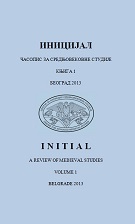Typology and Semantics of Cryptograms and Acrolexa in the Orthodox East in the Byzantine and Post-Byzantine Period
Typology and Semantics of Cryptograms and Acrolexa in the Orthodox East in the Byzantine and Post-Byzantine Period
Author(s): Emmanuel MoutafovSubject(s): Cultural history
Published by: Центар за напредне средњовековне студије
Keywords: typology; semantics; cryptograms; acronyms; Eastern Orthodoxy; Byzantium; Middle Ages
Summary/Abstract: As a matter of academic convention, combinations of Greek, Old Bulgarian and Latin letters found on various, mostly religious objects are called cryptograms. Lying somewhere between philology, art and medieval para-ecclesiastic culture, cryptograms have remained outside clearly defined fields of research. As a result, no attempt has been made to systematically decipher, ana-lyze and publish them. This article is composed of three main sections. The first discusses where and when cryptograms and acrolexa occur (personal use objects, iconography, monumental decoration, manuscripts and old-print books, fortifications, sepulchral and on-throne crosses, coffins, etc). The second is dedicated to the typology of cryptograms and acronyms based on semantic principles, classify-ing them by functions, such as apotropaic, soteriological, eschatological, eucha-ristic, invocational, mediative, therapeutic, etc. The third section explores whether cryptograms have the role of apotropaic iconographic symbols and proposes mechanisms for reading them
Journal: Иницијал. Часопис за средњовековне студије
- Issue Year: 2013
- Issue No: 1
- Page Range: 49-75
- Page Count: 27
- Language: English

